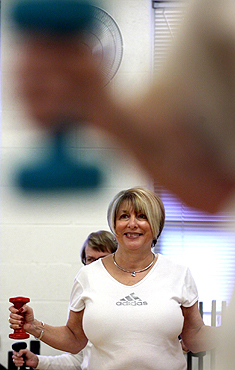|
|
Building Bones Helps Woman Battle Osteoporosis
By Harry Jackson Jr., St. Louis Post-Dispatch
January 23, 2008

Ann Birmingham joined an exercise class called Building Bones at OASIS at the Center in Clayton to increase her strength because of medicine that affected her bone density.
Ann Birmingham didn't know if the broken foot she suffered on a Labor Day trip
to the St. Louis Zoo resulted from impending osteoporosis, but she didn't want to take any chances.
Even before the accident, she was wary. Besides being over age 50, her mother has severe osteoporosis. In addition, Birmingham is taking a cancer medicine
that can weaken her bones.
Despite having been an athletic child and young adult, at age 60 she wasn't
exercising much other than an occasional visit to the treadmill and weight room
at her subdivision's clubhouse.
So the issue was on her mind when a friend urged her to visit a class called
Building Bones, which is operated by St. Louis Regional OASIS, a philanthropic organization that provides social, recreational and other services to people
over 50.
Building Bones is aimed specifically at those battling or trying to prevent osteoporosis.
For a couple of weeks, she watched her friend and participated now and then.
Then came the fracture in her right foot. "I knew about osteoporosis and bone
density, and a lot of bells went off in my head," Birmingham says.
THE CANCER
Birmingham's saga began in November 2003 when a suspicious breast lump was discovered. At first, doctors couldn't find any cancer.
But a persistent oncologist at the Midwest Breast Center in West County ordered an
MRI, a high-resolution imaging of a larger area around the suspicious location. She found traces of cancer elsewhere.
"It was a very early catch. I'm very grateful for that," Birmingham said, which
is why she made the special trip to thank her doctor.
A lumpectomy and radiation removed the cancer.
In a regimen that lasts five years, Birmingham started taking Arimidex, a drug
that prevents the return of some cancers. While the drug has a proven track
record, the side effects can include weakening of the bones.
Though Birmingham had gotten positive bone density checkups before the drug,
she experienced a slight reduction in density after taking it. Her doctor wasn't certain that the change was due to the drug or other factors.
"Even when the doctor said he didn't think it was the drug, it's my body and I just had this feeling," she says.
That's what prompted her visit to the Building Bones class, only to find it full.
A NEW APPRECIATION
Apparently, her story about the cancer was compelling enough that the
instructor, Suzanne Bruce, a physical therapist, allowed her to stay. Birmingham says the exercise improved her condition so fast that it amazed even
herself.
Her foot injury happened three weeks into the class, and that's when she got a
new appreciation for fitness. Her foot needed little therapy and healed quickly. In only a few weeks, she was back to exercising. She attributes the
quick recovery to the training.
Birmingham is the youngest of about two dozen people in the class.
The exercises are designed for people in danger of osteoporosis, Bruce says.
She has taught the 12-week sessions for more than seven years.
The exercises are mainly weight-bearing — those done while standing or lifting
weights. Also, "There's no bending forward or (situps)," or other exercises that stress weakened bones, Bruce says.
A session runs more than an hour and includes floor exercises with small weights and ends with stretching and a balance routine.
"I just feel better; my balance is better," Birmingham says. "I can feel, even in a short amount of time, stronger than before. Even with my foot, it's helped
me get the strength back faster."
GOOD THINKING
Experts say that Birmingham took the right route. Exercise can reverse osteoporosis or the precondition, even in the face of the cancer medicine.
Like muscle, bone is living tissue that responds to exercise by becoming stronger, the National Institutes of Health says.
Experts writing for the NIH recommend weight-bearing exercise such as walking, jogging, stair-climbing, tennis, weight-training and dancing. They strengthen
bones, build muscles and improve balance.
Balance is vital to older people because falls are a major cause of injury, fractures and death among people over 60.
WHAT NOW?
It's too early to tell if her bone density has reversed, but with increasing strength and energy, Birmingham is looking for new challenges.
This is her first year of not working as a substitute teacher, an occupation she used as a transition after 34 years as an elementary teacher in the Parkway
District.
Now, she's volunteering with the Cancer Center at Missouri Baptist Medical Center and planning to enjoy retirement.
"This is my first full year feeling like I have time to do what I want to do without being stuck in a schedule," she says.
In addition, this is her last year on the cancer drug.
"I just hope to be able to maintain my health, continue to be helpful, to volunteer and take care of my two grandchildren," she says.
More Information on US Health Issues
|
|



